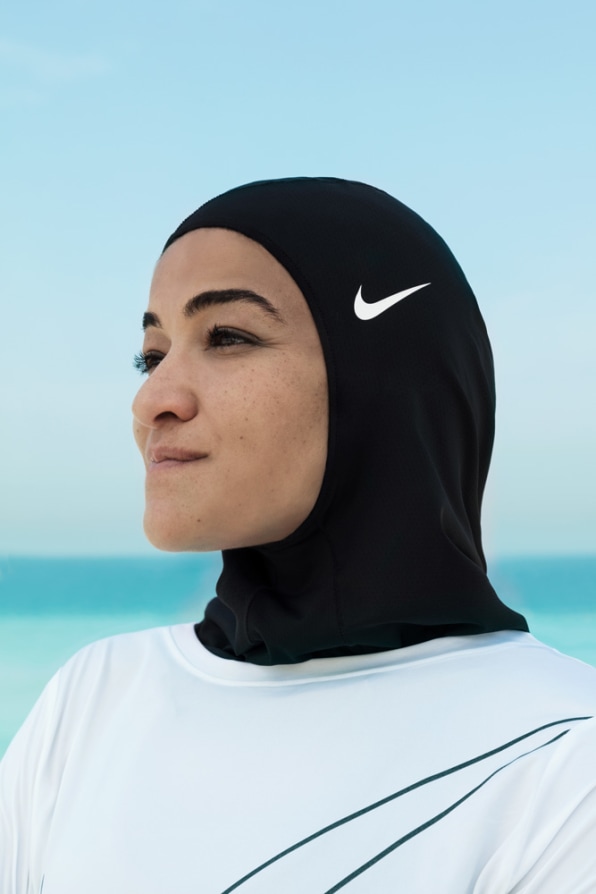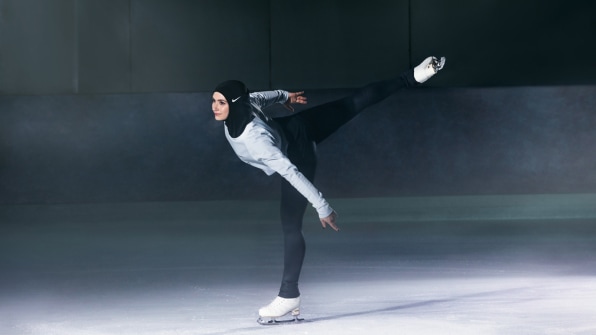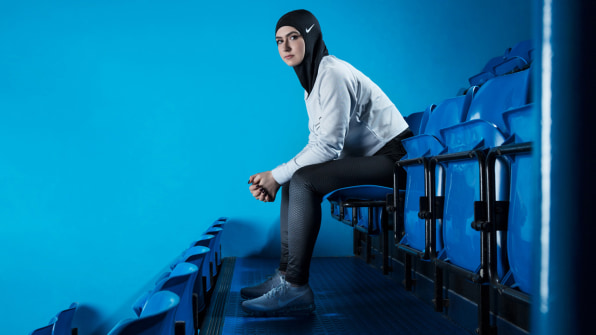By creating the Pro Hijab, Nike sends an important message about inclusion and encourages a generation of Muslim girls to think of themselves as athletes.
Nike’s Pro Hijab won General Excellence in the 2017 Innovation By Design Awards, Fast Company‘s annual celebration of the best ideas in design. See the rest of the winners, finalists, and honorable mentions here.
In 2017, Nike caused a stir when it announced that was getting into the hijab business. Early next year, it will launch the Pro Hijab, a lightweight, moisture-wicking head covering for female athletes.
At Nike’s headquarters in Beaverton, Oregon, designers were excited to tackle the challenge of creating a high-performance hijab that would make it easier for millions of Muslim women to do sports. But by crafting a product that was so deeply tied to the Muslim identity, Nike was wading into choppy waters. Within minutes of the product announcement, Nike’s hijab had morphed from a swath of high-tech fabric into a symbol of the empowerment of women and, simultaneously, their oppression.

Many Muslim women were thrilled that Nike was about to become a hijab-maker. Abeba, a hijab-wearing middle schooler who lives in Cambridge, Massachusetts, heard about the new product on a morning cable news show. Nike shoes and clothes are popular among her friends, and the fact that the brand had created something tailored to Muslim girls seemed like an inclusive gesture to her. “It made me feel special,” she told me. “It will make gym class so much easier.”Ababa’s excitement was echoed by Muslim women on social media and blogs. Amna Al Haddad, the Dubai-based weightlifter who inspired Nike to create the hijab, believes that the 800 million Muslim women around the world are no longer invisible as consumers. It was encouraging to her that large American apparel brands like Nike don’t see hijab-clad women as foreign or strange, but as valuable customers. “There’s a change happening in the world,” Al Haddad says. “You can see it when a big brand like Nike creates a sports hijab.”
But Nike also faced a negative backlash. On social media, some people equated Nike creating a hijab with Nike endorsing the wearing of hijabs. The hashtag #BoycottNike began popping up on Twitter and Facebook. “#Nike cashing in on the subjugation, domination, and oppression of women,” one Twitter user said. “I will never buy another Nike product again.”
Nike did not provide a direct response to this barrage of criticism but quietly continued with its plan to release the hijab in early 2018. Megan Saalfeld, a senior director of communications at Nike, tells Fast Company that she doesn’t believe it is Nike’s place to take a stand about whether or not women should wear the hijab. However, Nike is focused on gathering insights from athletes to create useful products–and the need for a hijab came directly from athlete feedback. “We take our cues from the women we speak with every day,” Saalfeld says. “And it was clear from working with Amna (Al-Haddad) that there was a need here that we could address.”
The idea for the hijab occurred to Nike’s designers two years ago, when Al-Haddad was training for the Rio Olympics. As a Nike-sponsored athlete, she had been invited to the company’s headquarters where researchers studied her in a lab–hooking her up to state-of-the-art body scanners and machines that mapped out her body heat–to see how they could help her better compete. But it turns out that what Al-Hadad really needed was far more basic: While she wears the hijab proudly, she explains that her head covering sometimes interfered with her sport. “It’s hard to train when your face and hair are sweaty because your hijab traps heat,” Al Haddad explained, when we spoke earlier this year. “It’s a distraction when it comes out of place while you’re moving.”
There are other, smaller brands on the market that offer athletic hijabs, such as Asiya, Capsters, and Artizara. Al-Haddad herself had chanced upon a stretchy hijab made by a local artisan at a market. But since she only had one of them, she had to hand-wash it in the sink every night. Nike believed it could provide a valuable alternative in the market by using its arsenal of high-tech fabrics to create a high-performing hijab–and using its global reach to make sure the product was widely available around the world. “We had all these lightweight, breathable materials that would work well and seams that would not irritate the skin,” Saalfeld says.

Nike’s designers created a prototype for Al Haddad. They then began researching the needs of hijab-wearing athletes around the world by speaking with elite athletes like Emirati figure skater Zahra Lari or Egyptian mountain climber Manal Rostom, as well as everyday women who enjoyed running, cycling, or studio classes.The design team also needed to take cultural issues into consideration as they developed the hijab. For instance, there are many regional differences to how hijabs are worn, so the Pro Hijab attempts to accommodate as many variations as possible. The designers also gathered the opinions of women from many local communities around the world to make sure the design met their cultural requirements around issues of modesty.

Nike’s designers then got to work on creating a sports hijab that could be sold worldwide. The final product appears simple, but it is full of high-tech features. It is made of a Nike’s “power mesh” that wicks away moisture and is full of tiny, strategically positioned perforations to optimize airflow, while remaining totally opaque. It is also elasticized, so it stays in place in the midst of vigorous activity, but is also soft, so it does not chafe.
But the Pro Hijab is much more than a well-designed head covering. By creating and marketing a sports hijab, Nike is encouraging Muslim women to think of themselves as athletes, which is a radical concept in some parts of the world. In the Middle East, for instance, many girls are not raised to exercise, play sports, or imagine becoming professional athletes. Fewer than one in seven girls in the region participate in physical activity for an hour a day, which is what experts recommend.
Shortly before Nike announced the launch of the Pro Hijab, Nike released an ad in the Middle East featuring women–some wearing the hijab–skateboarding, boxing, playing soccer, fencing, and ice-skating. The narrator in the voiceover starts saying that it is possible that some bystanders might say that you are unladylike for doing sports. But people might surprise you: They might describe you as strong, unstoppable, and the next big thing.
The very existence of the Pro Hijab suggests that Nike has its money on Muslim women.
–
This article first appeared in www.fastcodesign.com
Seeking to build and grow your brand using the force of consumer insight, strategic foresight, creative disruption and technology prowess? Talk to us at +9714 3867728 or mail: info@groupisd.com or visit www.groupisd.com


![[Photo: Vivienne Balla/courtesy Nike]](https://assets.fastcompany.com/image/upload/w_707)


